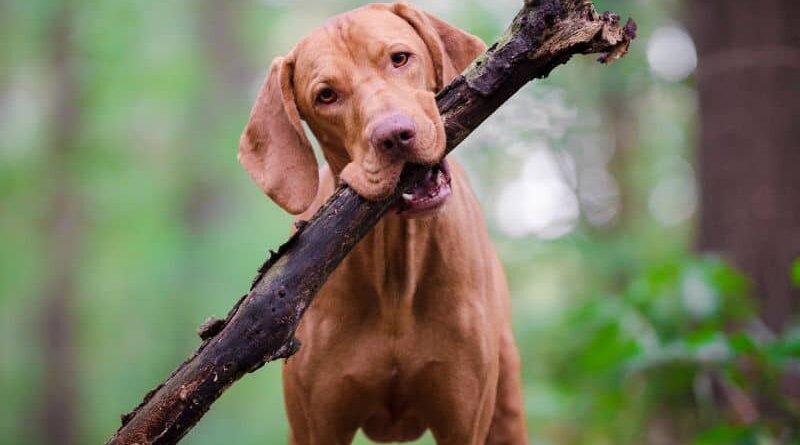What Is A Vizsla? – The Perfect Pup For Active Peeps
This post may contain affiliate links. We may earn money or products from the companies mentioned in this post.
Way back when I was raising my second guide dog puppy, Derby I wondered: What is a Vizsla?
Why did I ask that question? Well, we went on the Orange County Transit Authority (OCTA) Service Dog Training Day outing back in 2008.
I took my puppy in training, Derby for a bus ride and a visit to Knott’s Berry Farm.
OCTA sponsored the training day and allowed any service dog or service dog in training to ride the bus for free on that day.
One of the dogs we met that day was a cadaver dog in training.
While most of the service dogs in training were Labradors or Golden Retrievers this cadaver was noticeably a different breed.
Guess what dog breed he was?
That’s right! A Vizsla.
We asked the handler a lot questions and got answers about Vizslas and cadaver dogs but ever since then I’ve been curious about the Vizsla.
Today I present to you the perfect pup for active peeps, the Vizsla!
What Is A Vizsla?
A quick, short excerpt from Wikipedia says:
The Vizsla is a natural hunter endowed with an excellent nose and outstanding trainability. It was bred to work in fields, forests or bodies of water. Although they are lively, gentle-mannered, demonstrably affectionate and sensitive, they are also fearless and possess a well-developed protective instinct.
We’ve met this breed several times since our encounter on the OCTA buses. We always love to ask questions of their owners.
Two things have stood out during our conversations:
#1. Vizslas Are High Energy Dogs
They are a sporting breed and used for hunting so this is expected. What I didn’t expect was that people have told me they are more energetic then our Labs an Goldens.
#2. Vizslas Don’t Have That Dog Smell
I always thought this was an interesting fact about the dog especially since our Golden Retrievers have a distinct doggy smell especially when they get wet.
From what I’ve heard Vizslas do not have that characteristic doggy smell. While I’ve never taking a big whiff of any of the breeds I’ve come across, I’ve also never noticed any serious odor when around the breed.
That being said actually owning a Vizsla would be the real determining factor on whether or not they had that stinky, doggy smell.
Please if you own a Vizsla tell us a little about what they smell like in the comment section below.
Main Characteristics
Average Size
| SEX | HEIGHT | WEIGHT |
|---|---|---|
| Male | 22 – 24 inches | 55 – 60 pounds |
| Female | 21 – 23 inches | 45 – 55 pounds |
Energy Level
The Vizsla is a very high energy breed and as I mentioned earlier this has been confirmed by a half dozen owners we’ve run into over the years.
One of our good friends who recently brought home a Vizsla with the hopes of adding a new running partner to the family found out that her dog could run for days.
Color
The American Kennel Club recognizes the Vizsla in one color: Golden Rust.
The Vizsla is not found with any markings.
Health & Longevity
On average Vizsla’s live approximately 12-14 years. That’s around what I’d expect for a medium sized dog like the Vizsla.
According to the Vizsla Club of America, breeders should screen for the following conditions:
- Hip Dyplasia (OFA evaluation) – at 24 months or older
- Autoimmune Thyroiditis (OFA evaluation)
- Eyes (to be examined by a board-certified ACVO Ophthalmologist and registered with the OFA)
In addition, these optional health screens are recommended for breeding stock: - Elbow Dyplasia (OFA evaluation) – at 24 months or older
- Hip Dysplasia (PennHip evaluation) – at 24 months or older
- Cardiac (evaluation by a board-certified/ACVIM Cardiologist and registered with the OFA) – at 12 months or older
Epilepsy exists in the breed, as does lymphosarcoma and various skin issues.
Vizsla Temperament
Lively, loving and gentle – the Vizsla, or Hungarian pointer, makes for a versatile hunting dog as well as a loving companion for active families.
Bred to be a “walking gentleman’s shooting dog”, Vizslas spent hours upon hours in the field, and this energy level remains very much a part of the breed.
They possess an interesting mix of characteristics; they are a pointer that also has some retriever qualities.
This sounds a little bit like two of my Labs, Archer and Elsa. They both came from the same breeder and used to point as well as retrieve!
Athletic and light on their feet, Vizslas need a large fenced yard to romp in, but this should not be their only source of exercise, nor can they live outside.
They have considerable exercise, mental stimulation and companionship needs, without which they can become neurotic, hyperactive and destructive.
A minimum of one to two hours of vigorous exercise each day will keep everyone’s sanity.
Vizslas also love to chew, so it behooves their owners to supply them with a variety of chew and interactive toys.
Vizslas can make fine companions for active families, but their exuberance can be overwhelming to younger children, so older, active children are usually a better match.
Generally Vizslas get along well with other dogs, but cats and small animals are at risk. While polite and friendly to strangers, the Vizsla makes a good watchdog.
In fact, some can be barkers, and it is common for a Vizsla to “talk” to their people with various whining, moaning and groaning.
“Velcro Vizslas” describes this breed’s insatiable desire to be with their people.
Too much time alone and no job to engage in are the most common reasons Vizslas lose their homes.
Vizslas will chase small animals, so for their safety, must always be leashed unless in a fenced area.
Some people have been successful with a Vizsla in an apartment setting, but you should have places to exercise your dog close by, and remember this dog must have his exercise every single day; once these needs are met, Vizslas can be very cuddly.
Although more challenging, a Vizsla would be far better off in an apartment, getting sufficient exercise and stimulation, than being left alone in a large yard.
Vizslas need early and ongoing socialization to counter the tendency of many to be wary of strangers and novel experiences.
Socialization should begin in puppyhood and continue through the age of two.
The unique combination of pointer and retriever attributes make for interesting training; while Vizslas do have some of the pointer’s independent nature, they tend to be more willing than most pointing breeds.
You will experience the best results using positive reinforcement methods; harsh and highly punitive methods will likely shut down your Vizsla.
This breed is versatile not only in the field, but also in activities; they make for a versatile hunting dog, a jogging partner, and a fine companion for active families.
Jogging or running should not begin until growth is complete (~ two years) so as not to cause joint damage.
How Often Should I Groom My Vizsla?
The Vizsla’s coat is short, smooth and dense.
The smooth coat is the only type recognized by the American Kennel Club, but there also exist a wirehaired variety, a longhaired variety, and even a woolly.
The smooth coat is easy to care for; since dirt falls off, they stay very clean with little work.
Bathing can be done, as needed, but most owners just use a damp rag to freshen up their dogs.
Weekly brushing with a curry or soft bristle brush will keep the normal shedding to a minimum.
During spring and fall, the coat will “blow”, allowing new coat to come in; during these times, shedding will increase dramatically and brushing more frequently will lessen the hair falling in your house.
Ears should be kept clean and dry. Toenails should be trimmed; even if your Vizsla wears their nails down, you will want to maintain the ability to handle their feet, especially useful as they age, when wear to the nails typically slows down.
Teeth must also be checked and cleaned regularly.
How Much Does A Vizsla Eat?
The amount of food a Vizsla will require can vary depending on age, activity level, and type of food fed.
On average, Vizslas will eat 3 – 4 cups of food, fed in two meals per day; a high quality food should be fed.
Free feeding should be avoided.
A constant supply of fresh, clean water must always be available.
How Much Does A Vizsla Cost?
Prices for Vizslas vary widely, running from the $600-$1,000 range on up to $2,000.
Breed rescue organizations are another option, where lovely dogs needing a home can be found; adoption fees vary widely, but are generally in the $200-$500 range.
Whether you acquire a dog from a breeder or rescue, do your homework to be assured that the temperaments of the dogs are tested and sound.
Ongoing expenditures include the typical supplies, food, and regular vet visits.
Breeds Similar To Vizsla
- Pointer
- Weimaraner
- German Shorthaired Pointer
- German Wirehaired Pointer
Final Thoughts
We think the Vizsla is one of the most interesting breeds.
If you’ve been following us for a while then you already know we are a Golden Retriever and Labrador Retriever family. We even have a half Golden half Lab mixed breed.
However, since learning about the Vizsla way back in 2008 we’ve been intrigued.
A Vizsla may be in our future and maybe we can train one to be a service dog?
Do you have a Vizsla?
Tell us about your experiences with your dog in the comment section below.
Save To Pinterest
Top Picks For Our Puppies
- BEST PUPPY TOY
We Like: Calmeroos Puppy Toy w/ Heartbeat and Heat Packs – Perfect for new puppies. Helps ease anxiety in their new home. - BEST DOG CHEW
We Like: Bones & Chews Bully Sticks – All of our puppies love to bite, nip, and chew. We love using Bully Sticks to help divert these unwanted behaviors. - BEST DOG TREATS
We Like: Crazy Dog Train-Me Treats – We use these as our high-value treats for our guide dog puppies. - BEST FRESH DOG FOOD
We Like: The Farmer’s Dog – A couple months ago we started feeding Raven fresh dog food and she loves it! Get 50% off your first order of The Farmer’s Dog.
Check out more of our favorites on our New Puppy Checklist.




